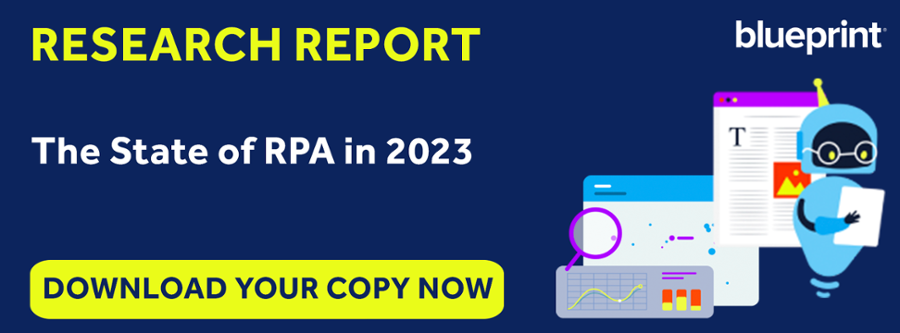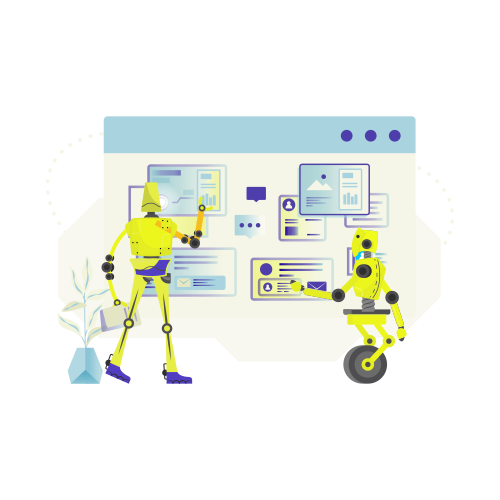A Tale of Two Types of RPA Migrations
There is a solid consensus in the automation space that there are two types of RPA automation migrations: those completed manually and those that use purpose-built technology to simplify the complexity of switching RPA platforms and ease the burden of investment in terms of finances and effort.
In Blueprint’s case, we typically start engagements with partners and clients after they’ve completed an initial assessment to determine what a manual RPA migration would look like in terms of logistics and level of investment.
In this article, using the real-life case of a Blueprint client, we present the two types of RPA automation migrations – manual and automatic – including what they can cost, how much effort they demand, and how long they can take.
Manual RPA Migrations
When organizations first need to migrate their automation estate from one platform to another, they will typically explore manual RPA migration as a first step. That doesn’t mean they intend to migrate their RPA environments and estates in-house manually; instead, they intend to engage with a service integrator (SI) or professional services company to complete the work.
According to Blueprint research on RPA Migrations in 2023, only 32% of the companies that had already switched RPA platforms did so with only internal resources.
Organizations very quickly realize that manual migrations are a costly and time-consuming process. There are a few reasons for this.
For starters, RPA tools specify process automations differently. To properly migrate them to a new RPA platform so they are compatible with the destination tool, an automated process:
- Must be investigated to understand what it does.
- The actions and services for that automation must be mapped to the destination RPA platform.
- The automation must then be essentially rewritten so that it becomes compatible to the destination RPA tool.
- The automation must be tested and deployed in the new RPA environment.
It is a painstakingly long process with significant effort involved that naturally costs a lot of money. The client in question initially estimated that their RPA migration for their 100-bot RPA estate would take two years to complete had they decided to do it manually.
One significant gap in the process of completing an RPA migration manually is the missed opportunity of thoroughly assessing your automation estate. An assessment of your estate during the migration process can help eliminate costly waste and shave hundreds of thousands of dollars off your automation total cost of ownership.
Automatic RPA Migrations with Purpose-Built Technology
The second type of RPA migrations are those completed with purpose-built solutions that do most of the work for you.
Using technology to perform your RPA migration automatically converts and maps your core actions and services from your existing RPA tool to your destination automation platform. There is no need to investigate each individual process automation to understand what it’s doing, and from there, map everything to your destination tool so that it’s compatible there.
Simply put, it’s much more cost-effective, saves time, and de-risks a project of this magnitude because it can be strategically planned out so that bottlenecks and extra costs from delays that necessitate running two platforms simultaneously can be avoided.
In the case of the client that inspired this post, they were able to migrate their entire RPA estate (70 bots totaling 200,000 actions) to Microsoft Power Automate in three months instead of their original estimate of 24 months (two years) had they performed the migration manually.
They were also able to realize 60% cost-savings for their RPA migration compared to the investment they would have made with a manual migration. Once they were up and running in Power Automate, they experienced a 40% reduction in their automation total cost of ownership because of how much more cost-effective Microsoft Power Automate is.
As a result of using Blueprint to power their RPA migration, this client performed an automation assessment as one of the primary steps in their migration process. The assessment enabled them to fully and transparently understand what they had in their RPA estate.
They could visualize which processes were delivering value and which were redundant and wasteful. Consequently, they decommissioned 30 automations to save even more money in their automation overhead in the process of switching RPA platforms.
You can read the full case study of the challenges this client faced and how they realized significant returns by choosing to perform their RPA migration with a purpose-built solution like Blueprint.
Conclusion
There are two ways to perform RPA migrations: manually and automatically with technology.
Manually costs much more money, takes more time to complete, and introduces significant project risks and delays.
Automatic RPA migrations with purpose-built solutions do all the heavy lifting, simplify the complexity of migrations, de-risk the project, all while saving you precious money and time.
Share this
Recent Stories

Why Are Customers Stuck on Legacy Versions of RPA Tools and How They Can Get Off Them

12 Application Considerations When Migrating RPA Estates to Microsoft Power Automate




